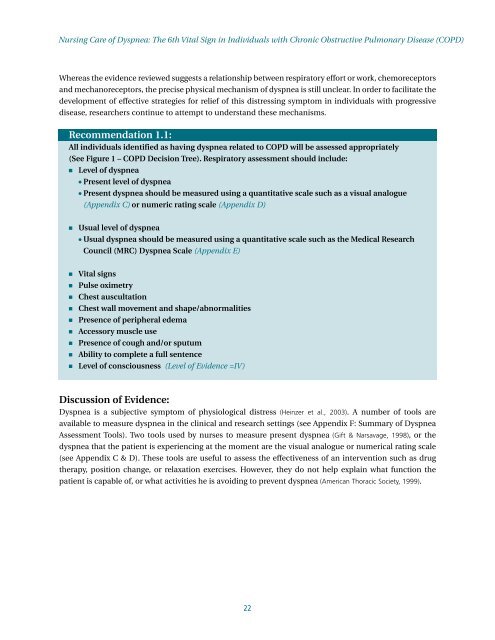Nursing Care of Dyspnea: The 6th Vital Sign in Individuals with ...
Nursing Care of Dyspnea: The 6th Vital Sign in Individuals with ...
Nursing Care of Dyspnea: The 6th Vital Sign in Individuals with ...
Create successful ePaper yourself
Turn your PDF publications into a flip-book with our unique Google optimized e-Paper software.
<strong>Nurs<strong>in</strong>g</strong> <strong>Care</strong> <strong>of</strong> <strong>Dyspnea</strong>: <strong>The</strong> <strong>6th</strong> <strong>Vital</strong> <strong>Sign</strong> <strong>in</strong> <strong>Individuals</strong> <strong>with</strong> Chronic Obstructive Pulmonary Disease (COPD)Whereas the evidence reviewed suggests a relationship between respiratory effort or work, chemoreceptorsand mechanoreceptors, the precise physical mechanism <strong>of</strong> dyspnea is still unclear. In order to facilitate thedevelopment <strong>of</strong> effective strategies for relief <strong>of</strong> this distress<strong>in</strong>g symptom <strong>in</strong> <strong>in</strong>dividuals <strong>with</strong> progressivedisease, researchers cont<strong>in</strong>ue to attempt to understand these mechanisms.Recommendation 1.1:All <strong>in</strong>dividuals identified as hav<strong>in</strong>g dyspnea related to COPD will be assessed appropriately(See Figure 1 – COPD Decision Tree). Respiratory assessment should <strong>in</strong>clude:■ Level <strong>of</strong> dyspnea● Present level <strong>of</strong> dyspnea● Present dyspnea should be measured us<strong>in</strong>g a quantitative scale such as a visual analogue(Appendix C) or numeric rat<strong>in</strong>g scale (Appendix D)■Usual level <strong>of</strong> dyspnea● Usual dyspnea should be measured us<strong>in</strong>g a quantitative scale such as the Medical ResearchCouncil (MRC) <strong>Dyspnea</strong> Scale (Appendix E)■■■■■■■■■<strong>Vital</strong> signsPulse oximetryChest auscultationChest wall movement and shape/abnormalitiesPresence <strong>of</strong> peripheral edemaAccessory muscle usePresence <strong>of</strong> cough and/or sputumAbility to complete a full sentenceLevel <strong>of</strong> consciousness (Level <strong>of</strong> Evidence =IV)Discussion <strong>of</strong> Evidence:<strong>Dyspnea</strong> is a subjective symptom <strong>of</strong> physiological distress (He<strong>in</strong>zer et al., 2003). A number <strong>of</strong> tools areavailable to measure dyspnea <strong>in</strong> the cl<strong>in</strong>ical and research sett<strong>in</strong>gs (see Appendix F: Summary <strong>of</strong> <strong>Dyspnea</strong>Assessment Tools). Two tools used by nurses to measure present dyspnea (Gift & Narsavage, 1998), or thedyspnea that the patient is experienc<strong>in</strong>g at the moment are the visual analogue or numerical rat<strong>in</strong>g scale(see Appendix C & D). <strong>The</strong>se tools are useful to assess the effectiveness <strong>of</strong> an <strong>in</strong>tervention such as drugtherapy, position change, or relaxation exercises. However, they do not help expla<strong>in</strong> what function thepatient is capable <strong>of</strong>, or what activities he is avoid<strong>in</strong>g to prevent dyspnea (American Thoracic Society, 1999).22
















